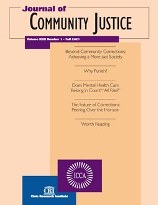Complete Issue
Author: Donald G. Evans.
Source: Volume 24, Number 04, Summer 2015 , pp.1-20(20)

< previous article |return to table of contents
Abstract:
Dr. Ronald P. Corbett, Jr., and Dr. April Pattavina provide us with an insightful and informative perspective on developments in the use of electronic monitoring, especially in light of the refocus on rehabilitation in response to developments in evidence-based practice. The authors examine the potential of electronic monitoring as a tool in conjunction with the principles of evidence-based practice and conclude that this linking can make a significant contribution to community corrections. An interesting topic addressed briefly in this article is the concept of behavioral economics and the role that poverty and scarcity—experienced by the majority of supervised populations—play in offenders’ rehabilitation. We should give this issue more attention and find ways to adjust our supervision practices to deal with the problem in meaningful and helpful ways. Howard Sapers, Correctional Investigator of Canada, in his address to ICCA’s 22nd Annual Conference last September, provided an overview of the work of his office and of its most recent report regarding the treatment of offenders in the Canadian correctional system. Of note are some interesting findings that suggest avenues for community correctional practitioners to explore. For example: Offenders being released from prison are finding that they are inadequately prepared for life outside; Declining parole rates mean that the majority of releases are statutory; An aging offender population and the prevalence of mental health problems and substance abuse are significant challenges that need to be addressed; and the barriers created by having a criminal record in seeking employment are coupled with the fact that the work experience provided in prison rarely matches the requirements of employers in the community. Sapers calls for corrections to pay more attention to transition planning and continuity-of-care processes and suggests as an example the simple but apparently difficult-to-achieve matter of releasing offenders from prison with adequate personal identification. Sapers concludes his discussion by noting the need to “continue to build our knowledge, keep in mind our purpose, and apply what we know.” Our book review editor, Russ Immarigeon, has assembled a fine collection of reading that covers current challenges needing attention and advocacy. The issues explored in these eight reviewed books deal with life sentences, race and the criminal justice system, young prisoners, senior prisoners, and recent research on restorative justice and the victims of violence. Of the eight books reviewed in this section, two are of particular interest in light of recent legislative initiatives in Canada related to “life without parole” and efforts to increase penalties for first degree murder from 25 years before parole consideration to, in cases of multiple murders, serving consecutive terms for each murder before consideration for parole. It seems that the alternative to the death penalty is, in the words of Joshua Price, a “slow death” in prison. Price’s book “Prison and Slow Death’ and Margaret Liegey’s “The Forgotten Men: Serving a Life Without Parole Sentence” are must-reads for policymakers and correctional administrators in any country, but especially in Canada.Keywords: Offender employment; Electronic monitoring; Reintegration in Canada’s Federal Correctional System
Affiliations:
1: Journal Editor.